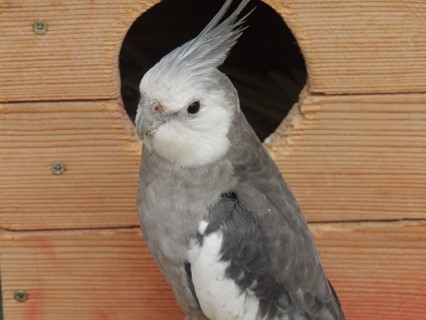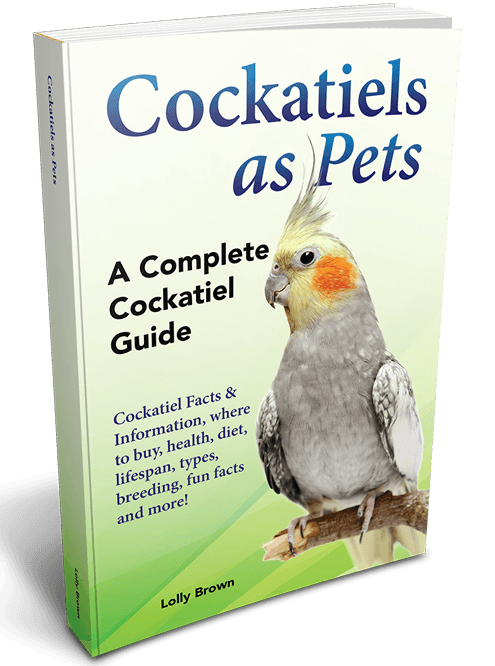CHAPTERS
Navigate to chapter
► Chapter One: Introduction
► Chapter Two: Cockatiels in Focus
► Chapter Three: Cockatiel’s Requirements
► Chapter Four: Tips in Buying Cockatiels
► Chapter Five: Maintenance for Cockatiels
► Chapter Six: Keeping Cockatiels Healthy
► Chapter Seven: Cockatiel Checklist
Chapter Five: Maintenance for Cockatiels

Assuming that you have already bought a Cockatiel as your pet, the responsibility that comes with it is the most crucial part of the process. You as the owner, have to provide for its basic needs so that it will be healthy and happy. In this chapter you will learn the different requirements needed for your bird such as its cage, accessories and food necessary for the maintenance of your Cockatiels.
Cockatiels have adapted well to human-modified habitats, such as parks and gardens in villages and towns. Like other kinds of birds, Cockatiels should be kept in a bird-safe environment. As the owner you need to have knowledge of its habitat requirements and environmental conditions to ensure that your bird is healthy. You will find tons of information in this section regarding the maintenance your pet needs in order to keep them happy.
a.) Ideal Cage Size for Cockatiels
Cockatiels, like other birds, loves lots of space when it is inside its cage. A general guideline that you can follow when it comes to bird cages is that, the parrot should not have restricted movements and should be able to flap its wings without touching the sides of the cage.
It is also advisable to buy a durable cage preferably with locks to prevent them from escaping because they are naturally curious and quite naughty at times.
The cage should ideally provide room for both horizontal exercise and vertical climbing. A minimum of 24″x18″x24″ (70x46x40cm) with ½ to 1 inch (3 cm) bar spacing is the recommended cage size for Cockatiels.
It is also advisable that the cage material uses non-toxic paint or else it can cause your pet to be poisoned by metal. It shouldn’t also be made out of brass either because it contains zinc which could kill your parrot as well.
Ideally the cage should also have at least three doors. One as the main entrance and the other two should be used for food and water.
Your bird will be spending most of their lives inside the cage that’s why it needs to be large so that it can also accommodate lots of toys and perches.
Your parrot’s cage could affect the health of your pet so it’s very important that you check it daily for any dirt, like its feces and spoiled food left in perches and cups to prevent health problems.
You should also change the cage paper every other day as well as check the metal parts & bars of your bird’s cage periodically for chipped paint and rust, because your bird will most likely chew or swallow the flaked pieces.
You should be able to clean the cage thoroughly at least once every month. You could use a mild dishwashing liquid or bleach with warm water for about a minute. Then rinse all soap and bleach thoroughly with water before letting your bird inside the cage.
c.) Location of the Cage
Finding the perfect cage is just as important as knowing where to place it. As established earlier, Cockatiels are most of the time quite talkative and noisy, that’s why you should also take that into consideration when finding a good location for your bird.
Put them in a place where they’ll get to interact with people, and won’t be too much of a disturbance at the same time – if in case they talk non-stop, and they will!
Put the cage at an eye level to create a sense of confidence in your bird and place the cage in a higher location so that they would feel secure just like in the wild.
Avoid placing the cage near dangerous fumes or drafts, this might kill them. Do not also place it directly in a window because the sun can cause your parrot to become ill due to too much heat. If it helps you can at least find a shade or cover for the cage, so that your bird may get just the right amount of heat during the day and feel comfortable during night time.
Finding the right location of the cage could lessen stressful situations for your bird so that they can enjoy their life with their new owner.
d.) Recommended Supplies
Now that your cage is all set and you already have an idea on where to properly place it, you need to provide supplies to meet its needs. Here are the recommended supplies that your Cockatiels needs:
Perches
The main purpose of perches is to exercise your bird’s feet; it could also prevent sores and foot related health issues in the future. In the wild, birds like Cockatiels, are used to transferring from one tree to another but in captivity of course they can’t do that, so a great alternative is to buy them perches, preferably made out of fresh fruit tree branches. The minimum area for the perch is about
5/8” – 1 ¼” in diameter.
You can buy different types of perches such as wood dowel, natural branch type, a therapeutic perch or a cement perch as well as Eucalyptus branches; just make sure that it is not poisonous.
Cockatiels also love to gnaw perches, and because of that you may have to replace it regularly. There are lots of perches you could choose from especially from online stores. These perches could also be used as ropes and swings for your pet. Do not put the perch above the bird’s bowl or dishes otherwise the food and water will be contaminated.
Toys
Cockatiels are very playful and active and like any other birds, they will chew anything, you may find yourself regularly buying and replacing new toys to keep them happy. It is recommended that you purchase toys that are easy to be destroyed, it’ll be very interactive for your Cockatiels to prevent boredom. However, if you’re in a tight budget, you can also buy toys that are durable so that it could last longer. There are a lot of toys online and in pet stores that you can buy for your Cockatiel.
It is not advisable to put all of the toys inside your bird’s cage because it will become dirty and overcrowded. Rotate the toys at least once a week.
Dishes
Buy at least 3 sturdy dishes; one for fresh water, one for pellet or seed mix and one for fresh foods. Avoid buying plastic dishes because your Cockatiels will most likely break it and it could also be harmful to its health. Place it away from the perches so that it would not be contaminated with bird droppings.
Continue Reading…
Want to read the entire thing?

